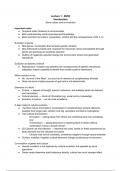Lecture 1 - 06/02
Introduction
Gene-culture and co-evolution
Important notes
● Temporal order (timeline) is recommended
● Both understanding social processes and knowledge
● Most important are culture, cooperation, conflict and the consequences of the 3 c’s
Evolution of genes
● New genes, combination that increase genetic variation
● New individuals compete and cooperate for resources; those well-adapted (through
genes and learning) are positively selected
● Outflow of negatively selected change the environment where next generation
reproduces
Evolution as dynamic network
● Reproduction, variation and selection are consequences of specific interactions;
adaptation means capability to benefit from certain positive interactions
What evolution is not
● No ‘’survival of the fittest’’, but survival of networks of complimentary diversity
● Does not serve a higher purpose of goal and is not deterministic
Elements of culture
● Culture → aspects of thought, speech, behaviour, and artefacts which are learned
and transmitted
● Cultural element → chunk of information (eg. social norms, knowledge)
● Evolution of culture → we can look at patterns
3-step model of cultural evolution
● (1a) New culture (innovation): combination of complementary cultural elements,
possibly from longer past, random luck (eg. aeroplane and boat is hydroplane)
● (1b) Cultural transmission
- Innovation → taking ideas from others and combining them into something
new
- Transmission → taking ideas from or teaching them to others without
combination, hence a simple version
● (2) Cultural use and selection → elements are used, based on these experiences we
keep elements we find valuable and useful
- Choices may not be voluntarily; sometimes happens through natural selection
● (3) New, modified, forgotten cultural elements change social/natural environment
Co-evolution of genes and culture
● Genetic evolution is not replaced by cultural evolution, but speeded up since
agriculture
● Genes rarely determine adult behaviour directly; culture has much stronger effect
, Lecture 2 - 08/02
Introduction
Foragers
Evolution applied to culture
● Combination of cultural elements into new element
● Transmitted
● Users interact, influenced by others, select cultural elements
● Elements are created, kept, forgotten, change the socio-cultural and natural
environment
Neanderthals (400,000 - 40,000 bce)
● Social groups smaller than homo sapiens
● Less interaction than other groups
● Patrilocal groups (men stay put, women look for partner in other groups)
Culture
● Fire, cooking, tools with different materials (wood, stone), spears, language, burials,
jewellery, paintings
● No evidence for counting
Theories of survival
● Outcompeted by sapiens
● Infection diseases from sapiens from Africa
● Too small groups, traces of incest
Sapiens
● Walking from Africa
● Settled into Europe
● Manage to survive and adapt through culture
● Cultural adaptation much faster than genetic adaptation
Ongoing innovations by foragers
● Stone tools
● Seafaring boats
● Weapons (blowgun, bow & arrow, spears)
● Pottery, transmitted through social network to Eastern-Europe
● Baking bread from wild cereals
Social life
● At foci (family, places where water/food can be found, shelter), conversations and
shared activities make people more similar
● Homophily → principle of social bonding
● Transitivity → if person A and B have common friend C, much higher chance A and B
connect





